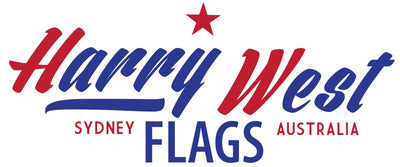Introduction
Flags have long been a symbol of identity, pride, and unity. Whether it's the national flag fluttering in the breeze or a personal banner celebrating a special occasion, proper flag flying etiquette is essential to show respect and honour. In this blog, we will delve into the rules, tips, and protocols for flying a flag with the dignity it deserves.
Flag Placement and Positioning
One of the fundamental aspects of flag etiquette is correct placement. The national flag, when displayed alongside other flags, should hold a place of honour. In many cases there are three poles with the middle one being taller, the Australian flag takes precedence and should be placed in the superior middle spot, often with the Aboriginal Flag and Torres Strait Islander Flag on either side. When flags are being hung on a wall or there are three seperate poles of the same height, the national flag again takes precedences and is positioned to the observer's left, with other flags placed to the right. The national flag should always be raised first and lowered last, emphasising its prominence.
Flags should always be flown freely and as close as possible to the top of the flagpole with the rope tightly secured. Do not fly two flags from the same flagpole. When the flag is raised or lowered or is carried in a parade or review, everyone present should be silent and face the flag and people in uniform should salute. Do not fly the flag upside down, even as a signal of distress. Do not allow the flag to fall or lie on the ground or be used as a cover (although it can be used to cover a coffin at a funeral)
Respecting the Half-Mast Position
Lowering the flag to half-mast is a powerful gesture of mourning or remembrance. This position symbolises respect for a national tragedy or the passing of a prominent figure. When raising the flag to half-mast, ensure it reaches the position first before hoisting it to the top, and when lowering, raise it to the top before lowering it. It's crucial to know the specific dates and occasions that warrant this gesture.
Lighting and Visibility
Only fly the flag at night when it is properly illuminated. To ensure visibility, illuminate the flag with a light directed at it from below. This not only adheres to proper protocol but also highlights the flag's colours and symbols. When raising or lowering the flag in the evening, do so with care and respect, ensuring the process is well-lit. Do not raise the flag earlier than first light or lower the flag later than dusk.
Weather Considerations
Inclement weather can pose a challenge to flag flying. During storms or strong winds, it's advisable to lower the flag to prevent damage. Woven bunting flags are more resilient to adverse weather conditions, but regardless of the material, regularly check for wear and tear to ensure the flag remains in good condition. We offer free repairs on flags but this should occur when damage is first seen and before the flag is too far gone, in order to effectively increase longevity. If you are taking your flag down regularly due to the weather, you will notice the first signs of wear and this is when you should contact us about repairs.
Flag Size and Proportion
The size and proportion of the flag matter when it comes to display. A flag that's too small might convey a lack of respect, while one that's too large can be overwhelming. Research and adhere to guidelines that dictate the appropriate size for different occasions, ensuring the flag's visual impact aligns with its significance. For a standard 20-foot (6-metre) residential outdoor flag pole, we recommend a 2-yard flag as the rules state that for every 3 metres of pole there should be 1 yard of flag (horizontal dimensions).
Proper Disposal
When a flag becomes worn, torn, or faded, it should be retired with dignity. Flying a worn out flag defeats the purpose of showing respect or pride, do not fly a flag if it is damaged, faded or dilapidated. We offer a flag recycling service, where you can bring in your old Harry West flag when replacing it with a new one. We remove the hardware and send it to our textile recycling partner, allowing the material to get a second life.
Conclusion
Flying a flag is more than a simple act – it's a declaration of identity, pride, and unity. Adhering to proper flag etiquette and protocol is not just a tradition; it's a way to show respect for the symbols that represent us. By understanding the rules, following tips, and embracing the significance of each gesture, we can ensure that every flag is flown with the honour and dignity it deserves.


